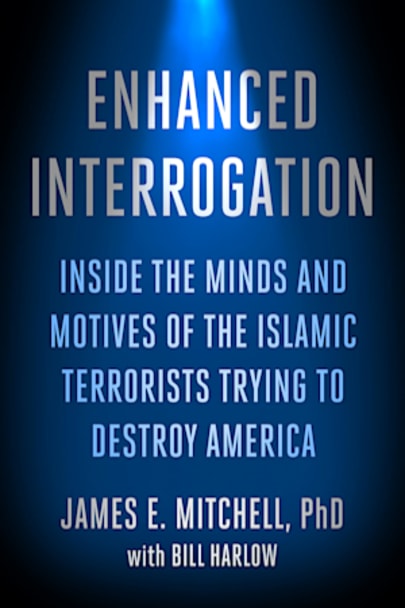In the dark days immediately after 9/11, the CIA turned to Dr. James Mitchell to help craft an interrogation program designed to elicit intelligence from just-captured top al-Qa’ida leaders and terror suspects. A civilian contractor who had spent years training U.S. military members to resist interrogation should they be captured, Mitchell, aware of the urgent need to prevent impending … impending catastrophic attacks, worked with the CIA to implement “enhanced interrogation techniques”–which included waterboarding.
In Enhanced Interrogation, Mitchell now offers a first-person account of the EIT program, providing a contribution to our historical understanding of one of the most controversial elements of America’s ongoing war on terror. Readers will follow him inside the secretive “black sites” and cells of terrorists and terror suspects where he personally applied enhanced interrogation techniques.
Mitchell personally questioned thirteen of the most senior high-value detainees in U.S. custody, including Abu Zubaydah; Abd al-Rahim al-Nashiri, the amir or “commander” of the USS Cole bombing; and Khalid Sheikh Mohammed, the mastermind behind the September 11, 2001, terror attacks–obtaining information that he maintains remains essential to winning the war against al-Qa’ida and informing our strategy to defeat ISIS and all of radical Islam.
From the interrogation program’s earliest moments to its darkest hours, Mitchell also lifts the curtain on its immediate effects, the controversy surrounding its methods, and its downfall. He shares his view that EIT, when applied correctly, were useful in drawing detainees to cooperate, and that, when applied incorrectly, they were counter-productive. He also chronicles what it is like to undertake a several-years-long critical mission at the request of the government only to be hounded for nearly a decade afterward by congressional investigations and Justice Department prosecutors.
Gripping in its detail and deeply illuminating, Enhanced Interrogation argues that it is necessary for America to take strong measures to defend itself from its enemies and that the country is less safe now without them than it was before 9/11.
more



Enhanced Interrogation: torture or not?
I’m not going to answer that question here, but if you read ENHANCED INTERROGATION, you’ll have the best evidence with which to decide for yourself.
The book’s author, Dr. James Mitchell, was a central figure in developing the CIA’s enhanced interrogation methods after 9/11 and took part in interrogating fourteen of the most senior high-value detainees in U.S. custody, including Khalid Sheikh Mohammed (mastermind of the 9/11 attack), Abd al-Rahim al Nashiri (leader of the USS Cole bombing), and others. Prior to working in the CIA’s interrogation program from 2002 to 2009, Dr. Mitchell served 22 years in the U.S. Air Force, including seven years in the USAF Survival School, where U.S. pilots are routinely subjected to many of the techniques during their training, including water-boarding, that form the basis of the CIA’s enhanced interrogation program.
Dr. Mitchell describes in the book how the CIA’s enhanced interrogation methods were developed, how they were applied, how well they worked, what intelligence was obtained through their use, and gives a colorful account of work at the CIA Black Sites where the high-value targets like KSM were detained. In the latter portion of the book, Dr. Mitchell also lays out in detail the political backlash to the use of the enhanced methods and the persecution that ensnared many CIA officers who applied them.
As anyone who has worked in the national security apparatus might expect, the animosities that arose during the program did not all play out between interrogators and their terrorist subjects. Nearly as tense were the sharp-elbowed exchanges between the interrogation staff and the CIA station personnel in the countries where the Black Sites were located, between the field stations and CIA Headquarters, and between the CIA officers and the FBI officers who worked together at the interrogation sites. Over the years, some of the people who participated (and many who were only peripherally involved) have spoken or written of their experiences with the program, contradicting each other on many points. So who is to be believed?
The mainstream press has spoken with one voice to condemn the enhanced interrogation methods as torture. Then there is the 2014 Senate Select Committee Report on CIA Torture, which was not issued by the full committee, but only by the Democrat majority. Moreover, Senator Feinstein’s committee staff relied solely on written materials, declining to interview Dr. Mitchell or any CIA personnel who participated in the interrogations, even after Attorney General Eric Holder dropped in 2012 all prosecutions arising from the interrogation program and removed any legal conflicts that might have arisen while some of the CIA people involved were in legal jeopardy. Had the Senate Majority staff spoken to officers with first-hand knowledge, many of the Majority Report’s inaccuracies might have been avoided.
This is not to recommend against reading the Majority Report, but if you do, read also the Republican Minority Report and the rebuttals of key CIA officials presented in their article (Rebuttal: The CIA Responds to the Senate Intelligence Committee’s Study of the Detention and Interrogation Program) published in 2015 by the Naval Institute Press.
Retired CIA official José Rodriguez’s memoir [Hard Measures: How Aggressive CIA Measures After 9/11 Saved American Lives, 2013] is another first-hand account of the events described in Dr. Mitchell’s book, and corroborates much of his story.
As a former U.S. government official posted to the Middle East prior to 9/11 who is well acquainted with Islamist terrorism, I read both Dr. Mitchell’s book and Mr. Rodriguez’s memoir with great interest and came away with a strong appreciation for what they and their co-workers accomplished in those days to keep America safe. I also left with the hope that their enhanced interrogation methods will remain available should the country require them in the future.